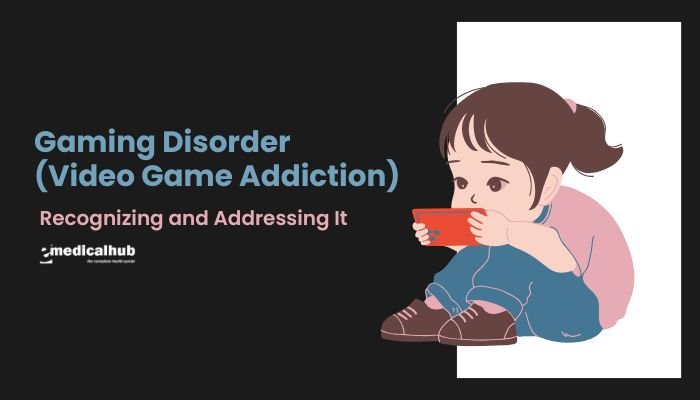Introduction
Video gaming is a worldwide phenomenon enjoyed by billions of people across diverse platforms, from consoles and PCs to smartphones. For most, it’s a fun pastime or a competitive hobby. However, gaming can become problematic when it takes over a person’s life, harming daily functioning, relationships, and well-being.
In 2019, the World Health Organization (WHO) officially recognized gaming disorder as a condition in the International Classification of Diseases (ICD-11), underscoring that while the majority of players do not develop such issues, some individuals do experience negative consequences akin to addiction.
If you or a loved one spends countless hours gaming, skips responsibilities, or prioritizes gaming over health and personal relationships, it might be time to consider the possibility of gaming disorder. This article provides an overview of what gaming disorder (or so-called “video game addiction”) is, how to recognize its signs, risk factors that lead to problematic play, and strategies for addressing it. While healthy gaming can offer enjoyment and social engagement, crossing the line into compulsive play calls for informed steps toward regaining balance.
Disclaimer: This guide serves as general information, not a substitute for professional medical or psychological advice. If you suspect a gaming disorder or related mental health concerns, consult a licensed healthcare provider for personalized evaluation and support.
Defining Gaming Disorder
Official Recognition
In the ICD-11, the WHO defines gaming disorder as a pattern of persistent or recurrent gaming behavior—digital or video—characterized by:
- Impaired Control: Difficulty controlling gaming frequency, intensity, and duration.
- Increasing Priority Given to Gaming: Gaming takes precedence over other activities and interests.
- Continuation Despite Negative Consequences: Gaming continues (or escalates) even with significant harm to personal, family, social, educational, or occupational areas of functioning.
Crucially, symptoms must be evident for at least 12 months (unless symptoms are severe) to qualify for diagnosis, distinguishing it from short-term gaming binges.
What Makes Gaming Addictive?
Several factors can make video games compelling:
- Reward Systems: Many games use reinforcement schedules—scoring points, leveling up, or collecting in-game rewards—that mimic patterns found in gambling or other addictive behaviors.
- Online Connectivity: Multiplayer games can foster social pressure or loyalty to an online community, leading to extended sessions.
- Escapism: Immersive environments allow individuals to escape daily stress or negative feelings, reinforcing repeated play as an emotional coping mechanism.
When these elements converge, players vulnerable to addictive patterns may find it difficult to moderate their gaming time.
Signs and Symptoms of Gaming Disorder
Behavioral Indicators
- Preoccupation with Gaming: Constant thoughts about next play sessions, or planning game strategies during non-gaming activities.
- Loss of Interest in Other Activities: Hobbies or friendships outside gaming fade away; chores, schoolwork, or exercise often neglected.
- Inability to Reduce or Stop: Multiple unsuccessful attempts to control or cut back on gaming.
- Continued Play Despite Harm: Even as school performance drops or relationships strain, the individual persists with excessive gaming.
Emotional and Psychological Effects
- Restlessness or Irritability if unable to play.
- Euphoria or Relief only when gaming, creating a cycle of dependency.
- Depression or Anxiety if gaming time is restricted or if real-life issues build due to neglected responsibilities.
- Denial or downplaying the extent of time spent playing.
Physical Warning Signs
- Fatigue or Disrupted Sleep: Late-night gaming sessions can cause insomnia and chronic tiredness.
- Headaches or Eye Strain: Resulting from prolonged screen time.
- Neglected Hygiene: Some individuals skip meals or showers to maintain play sessions.
- Musculoskeletal Problems: Repetitive strain in wrists or shoulders due to long durations at a console or PC.
Not all who log many hours will experience every symptom, but a pattern of these signs suggests deeper issues with gaming behavior.
Risk Factors and Who’s Vulnerable
Demographics
Although gaming disorder can affect people of all ages, it is most commonly reported among adolescents and young adults. They may be more susceptible if:
- Limited Alternatives: They lack diverse recreational outlets or stable relationships.
- Emotional or Social Challenges: Games provide a sense of belonging or escape from real-world stressors.
- Peer Pressure: Online gaming can be a primary social environment, intensifying engagement.
Underlying Mental Health Conditions
People with certain psychological or emotional backgrounds might turn to gaming as a form of escapism:
- Depression or Anxiety: They may find immediate gratification or temporary relief in games.
- ADHD: Intense, fast-paced games might keep attention better than daily tasks.
- Low Self-Esteem: Gaining achievements or status in a virtual world can compensate for real-life insecurities.
Environmental Factors
- Lack of Parental Guidance: In children or teens, unmonitored gaming can quickly escalate.
- Stressful Home or Work Life: Games become a refuge from conflict or stress.
- Easy Access to Devices: Multiple gaming platforms within reach at all times can enable overuse.
Effects of Gaming Disorder on Life Areas
Social and Family Relationships
Excessive gamers can become isolated, ignoring friends or family events. Social bonds can wane or revolve solely around gaming networks, which might not fulfill real emotional needs. Family conflict can escalate over demands to limit gaming or concern for the individual’s well-being.
Academic or Work Performance
Time dedicated to gaming can overshadow responsibilities:
- Missed Deadlines: Homework or job tasks might be rushed or abandoned.
- Tardiness or Absenteeism: The individual may oversleep due to late-night sessions.
- Lack of Focus: Preoccupation with gaming reduces concentration in the classroom or workplace.
Physical Health
- Sedentary Lifestyle: Minimal movement leads to potential weight gain or cardiovascular risks.
- Nutritional Neglect: Skipping meals or opting for quick junk food.
- Carpal Tunnel or “Gamer’s Thumb”: Repetitive strain from constant controllers, keyboards, or phone screens.
Financial Consequences
Spending real money on in-game items, microtransactions, or subscription fees can cause debt or financial stress, especially if someone invests more than they can afford.
Differentiating Healthy Gaming from Problematic Behavior
Moderation vs. Addiction
Casual or moderate gaming is beneficial or harmless for many—enjoyment, relaxation, socializing. Warning lines are crossed when:
- Gaming consistently dominates free time.
- The user is unable to self-limit or follow time restrictions.
- Emotional well-being relies primarily on gaming achievements.
Self-Assessment Questions
- Am I sacrificing personal relationships, job performance, or health for gaming?
- Do I become irritable or anxious if I must stop playing?
- Have I tried to cut down on gaming but repeatedly failed?
If the answer is yes to multiple points, professional evaluation may be warranted.
Strategies for Addressing and Overcoming Gaming Disorder
Professional Help
- Therapy: Cognitive Behavioral Therapy (CBT) can help identify triggers, set boundaries, and replace gaming with healthier coping strategies.
- Group Support: Programs like “Online Gamers Anonymous” or local groups provide peer accountability.
- Psychiatric Evaluation: If co-occurring depression or anxiety is present, medication or other interventions might be beneficial.
Set Boundaries and Limits
- Scheduled Gaming Sessions: Restrict playing to specific times or durations (e.g., 1-2 hours daily).
- Device-Free Zones: Keep gaming consoles or PCs away from bedrooms to discourage late-night play.
- Use Time-Management Tools: Alarms or phone settings that lock gaming apps after a set usage limit.
Develop Alternative Interests
Expanding leisure activities reduces reliance on gaming:
- Exercise: Sports or gym sessions can offer an adrenaline rush but with physical health benefits.
- Creative Outlets: Music, art, writing, or any hobby that fosters engagement offline.
- Social Engagement: Face-to-face meetups, volunteering, or group classes.
Rewarding Real-World Goals
- Achievement Substitution: Shift your sense of accomplishment from virtual achievements to real tasks like learning a new skill or finishing personal projects.
- Positive Reinforcement: Celebrate incremental improvements (e.g., “I only gamed 2 hours tonight instead of 4.”)
Family and Peer Involvement
For younger gamers, parental oversight is critical:
- Consistent House Rules: Clear daily or weekly gaming time and accountability.
- Model Balance: If parents demonstrate healthy digital habits, children are more likely to follow suit.
- Communication: Explaining the reasons behind reduced gaming fosters understanding rather than rebellion.
Prevention and Healthy Gaming Habits
Early Education
Teaching youths about responsible gaming from an early age can help them differentiate real life from digital illusions, manage impulses, and keep gaming recreational rather than addictive.
Digital Wellness Tools
Many consoles and devices have built-in parental controls or timers. Apps can track daily usage, send alerts, or forcibly close games once a limit is reached.
Balanced Life Approach
- Physical Activity: Encouraging regular exercise invests in health and can reduce hyper-focus on gaming.
- Nutrition and Sleep: Proper rest and balanced diet keep mood stable, limiting the desire to escape reality via gaming.
- Meaningful Social Connections: Real-life friendships and support cultivate satisfaction beyond the screen.
The Role of Culture and Industry Responsibility
Gaming Industry Accountability
Game developers incorporate mechanics like loot boxes, microtransactions, or addictive reward systems. Ethical guidelines or regulations (like disclaimers or spending caps) can reduce risk of compulsion.
Cultural Norms
In certain societies, high rates of problematic gaming correlate with intense academic or job pressure, limited recreational alternatives, or ubiquitous e-sports scenes. Public awareness campaigns can address these root causes.
Government Policies
Some nations enforce stricter measures: e.g., China’s curfews for minors. But personal responsibility and education remain paramount for balanced usage.
Frequently Asked Questions (FAQ)
- Does all online gaming lead to addiction?
Not at all. Most players maintain healthy usage. Addiction emerges when gaming overtly interferes with major life areas—relationships, work, or mental health—and self-control is lost. - Can someone be addicted to mobile games as well, or only large-scale titles?
Any game—PC, console, or mobile—can potentially become problematic if combined with risk factors and lacks time constraints. Many mobile games use frequent reward loops prompting constant checking. - I’m worried about my teenage child. Should I ban games entirely?
Going “cold turkey” might lead to rebellion or secrecy. A better approach is open dialogue, negotiated limits, positive replacement activities, and, if needed, professional guidance. - Can therapy alone fix severe gaming disorder without reducing game time?
In most serious cases, therapy plus active limit-setting or game access restrictions is crucial. Behavioral changes must accompany psychological help. - What if gaming helps me cope with stress or depression?
In moderation, gaming can relieve stress. But if it’s your main (or only) coping strategy, it can overshadow more effective solutions. Therapy or alternative stress management might be beneficial.
Conclusion
Gaming disorder is real and recognized by leading health organizations, affecting a minority of gamers yet significantly harming those who fall into compulsive patterns. Recognizing the difference between healthy engagement in video games and problematic addiction is the first step. Signs include persistent inability to reduce playing time, neglecting important life domains, and enduring negative impacts on mental or physical health. While it’s easy to see gaming as mere entertainment, for some, it becomes a cycle of dependency and escapism.
Addressing this issue involves a multi-pronged approach. For individuals, that might mean limiting daily game time, exploring new hobbies, seeking therapy, or joining support communities. For families, open communication, consistent rules, and encouraging real-world achievements can help.
On a broader scale, the gaming industry and society as a whole can foster safer, more balanced gaming environments. If you or someone you know shows signs of gaming disorder, realize that professional help—whether from counselors, psychiatrists, or specialized programs—can support a healthier relationship with gaming, so it remains a fun pastime instead of a life-consuming addiction.
References
- World Health Organization. International Classification of Diseases, 11th Revision (ICD-11). WHO; 2019.
- American Psychiatric Association. Internet Gaming Disorder. In: Diagnostic and Statistical Manual of Mental Disorders, Fifth Edition (DSM-5). APA; 2013.
- Kuss DJ, Griffiths MD. Internet gaming addiction: A systematic review of empirical research. Int J Ment Health Addict. 2012;10(2):278-296.
- King DL, Delfabbro PH. Video game addiction. Curr Psychiatry Rep. 2018;20(3):1-10.
- Lopez-Fernandez O, Williams AJ, Kuss DJ, et al. Measuring female gaming disorder. Cyberpsychol Behav Soc Netw. 2019;22(8):517-26.
- Gentile DA, et al. Pathological video game use among youths: A two-year longitudinal study. Pediatrics. 2011;127(2):e319-29.
- Muller KW, Beutel ME, Egloff B, et al. Internet addiction in adolescents. Z Kinder Jugendpsychiatr Psychother. 2014;42(3):175-80.
- Rehbein F, Kleimann M, Moble T. Prevalence and risk factors of video game dependency in adolescence. Empirical analyses in a German nationwide survey. Cyberpsychol Behav. 2010;13(3):269-77.
- King DL, Delfabbro PH. The cognitive psychology of Internet gaming disorder. Clin Psychol Rev. 2014;34(4):298-308.
- Petry NM, O’Brien CP. Internet gaming disorder and the DSM-5. Addiction. 2013;108(7):1186-7.
- Király O, Griffiths MD, Demetrovics Z. Internet gaming disorder and the DSM-5: Concept, debate, and controversies. Curr Addict Rep. 2015;2(3):254-262.
- Charlton JP, Danforth ID. Distinguishing addiction and high engagement in the context of online game playing. Comput Human Behav. 2007;23(3):1531-1548.






